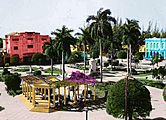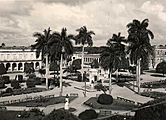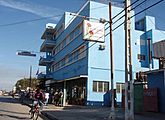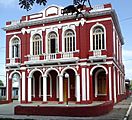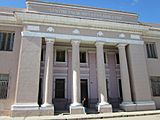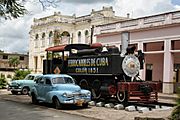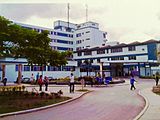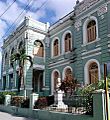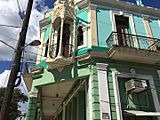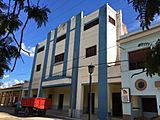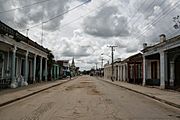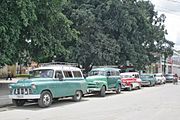Colón, Cuba facts for kids
Quick facts for kids
Colón
|
|
|---|---|
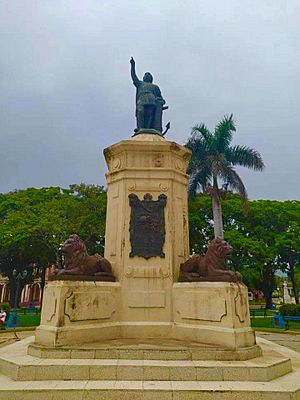
Christopher Columbus statue in Colón, Matanzas
|
|

Colón municipality (red) within
Matanzas Province (yellow) and Cuba |
|
| Country | Cuba |
| Province | Matanzas |
| Founded | 1846 |
| Established | 1859 (Villa) |
| Area | |
| • Total | 597 km2 (231 sq mi) |
| Elevation | 60 m (200 ft) |
| Population
(2022)
|
|
| • Total | 68,021 |
| • Density | 113.94/km2 (295.10/sq mi) |
| Demonym(s) | Colombino |
| Time zone | UTC-5 (EST) |
Colón is a city and a municipality in the Matanzas Province of Cuba. It is located on the western side of the island. The area of the municipality is about 597 square kilometers. Around 68,021 people live there. The city itself is home to about 44,000 people. This makes it the third-largest city in its province.
Contents
History of Colón
How Colón Started
The town of Colón was first founded in 1836. It was called Nueva Bermeja back then. A man named don Martín José Zozaya founded the town. He set aside land for a church and a cemetery. The official document to create the town was signed in Matanzas in 1836.
Growth of the Town
The railroad reached the area in 1843. It arrived right in the town by 1851. In 1852, the first public school opened. It was started by Fernando Diago, who owned a sugar mill. In 1859, the town was officially named Colón. This name honors Christopher Columbus, whose name in Spanish is Cristóbal Colón. At this time, it also became known as a villa, which means a larger town.
Changes Over Time
Before 1977, the municipality was divided into several areas. These included Agüica, Este, Guareiras, and others.
Geography of Colón
Where Colón is Located
Colón is surrounded by other towns and areas. It shares borders with Corralillo in Villa Clara Province. It also borders Los Arabos, Calimete, Jagüey Grande, Perico, and Martí.
Villages in the Area
The municipality of Colón includes several smaller villages. Some of these are Agüica, Banaguises, Guareiras, and México. Other villages include René Fraga, Río Piedras, and San José de los Ramos. Santa Gertrudis and Segio González are also part of the area.
People of Colón
In 2022, the municipality of Colón had a population of 68,021 people. The area is about 597 square kilometers. This means there are about 110 people living in each square kilometer. People from Colón are called Colombinos.
Architecture in Colón
Different Building Styles
Colón has many different building styles. You can see buildings from various time periods. These styles include Neoclassicism and Eclecticism. There are also buildings in Art Nouveau, Art Deco, and Rationalism styles.
Famous Buildings
The Catholic church, built in 1872, shows the Neoclassical style. The town hall also has this look. In the early 1900s, the School of Arts and Crafts was built. It shows the Eclectic style. Other buildings like the Ferrolana also have this style.
Modern Styles
From 1930 to 1959, new styles appeared. The Hotel Nuevo Continental, built in 1937, brought in the Art Deco style. The Teatro Canal is a great example of this. Later, the Rationalism style arrived. You can see this in the Santiago-Havana and Gran Caridad hotels.
Economy of Colón
Main Activities
Colón's economy is mostly about agriculture. Farmers grow sugarcane, tobacco, and citrus fruit. They also produce honey.
Other Industries
There is also some industry in Colón, like a spaghetti factory. Raising livestock (farm animals) is another important activity. Colón is also a key center for railway transportation.
Gallery
Notable people
Colón has been home to several famous people:
- Paul Casanova (1941–2017), a baseball player.
- José Miguel Fernández (born 1988), another baseball player.
- Oscar Nunez (born 1958), a Cuban-American actor and comedian.
- Mario Quintero (1924–2017), a basketball player.
- Félix Ramos y Duarte (1848–1924), an educator and writer.
See also
 In Spanish: Colón (Cuba) para niños
In Spanish: Colón (Cuba) para niños


